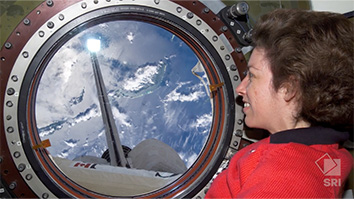
SRI and Stanford are among the leading global research organizations that have studied twins to better understand the genetic and environmental factors that drive human health and behaviors
When astronaut Scott Kelly departed Earth for a year at the International Space Station (ISS) in March 2015, he left behind a valuable research tool — his twin brother, Mark.
Since the first human cosmonaut went into space in 1961, scientists have looked for ways to better understand the impact of space travel on the human body. The Kelly brothers, who are both astronauts, provided a unique and exciting research opportunity. As identical twins, their DNA is as closely matched as two humans’ DNA can be. Comparing Scott and Mark’s biology — including their DNA — before Scott left for the ISS and over the course of the year while he was away enabled researchers to pinpoint the biological changes that can be caused by living in outer space.
The Kellys offer a prime example of how twin studies can accelerate scientific understanding into the relationship between humans’ DNA and individual environments, and how this relationship contributes to health, aging, behavior and disease. Identical twins start life with nearly identical DNA, so differences observed between them are likely attributable to their environments — i.e., individual lifestyle factors such as diets, exercise, stress, relationships and where they live. This was the case with the Kelly twins during Scott’s year in space. Fraternal twins, on the other hand, also start life in an identical environment, but share only about 50 percent of their DNA (similar to non-twin siblings). So any differences between them will be attributable to a more complicated mix of genetics and environment.
Scientific findings from twin studies — including better understanding about the causes of specific human behaviors and illnesses — can lead to improved disease-prevention guidance, as well as new treatments that benefit twins and non-twins alike.
Enlisting the Help of Twins
In 1875, Francis Galton, a relative of Charles Darwin, became the first known scientist to use twins in research. Galton coined the phrase “nature vs. nurture” and studied twins to try to tease out the impact of each.
In 1955, the U.S.-based National Academy of Sciences-National Research Council (NAS-NRC) began creating a voluntary registry of identical and fraternal twins. Targeting U.S. Armed Forces veterans — because their addresses and mortality data were readily available — this registry eventually grew to comprise about 20,000 individuals. It has provided twin subjects for many important health and medical studies over the past 65 years.
These include a landmark 1977 study conducted by the National Heart Lung and Blood Institute (NHLBI), which evaluated a subset of twin pairs from the NAS/NRC Registry to identify how genetics and environment influence specific cardiovascular disease risk factors. A 1992 study conducted by NHLBI, in partnership with researchers from the Center for Health Sciences at SRI International, utilized this same subset of twins to explore the impact of genetics on smoking behaviors. Other twin studies have provided important information about the genetic basis of diseases such as osteoarthritis, cataracts and anorexia nervosa.
SRI’s Twin Research Registry
In 1995, SRI researchers began recruiting twins for a new Northern California-based registry. These investigators had a track record of conducting important health studies utilizing twins, including an NHLBI study that led to a New England Journal of Medicine paper describing genetic influences on smoking. As a follow-up to that research, Dr. Gary Swan and colleagues at SRI wanted to create their own registry of adult twins to support more in-depth research into the factors that influence nicotine dependence and metabolism in humans.
The SRI team launched an advertising campaign to find twins who were interested in being part of a new SRI Twin Research Registry (TRR). The team enrolled more than 1,000 adult twins in 2.5 years. Eventually, membership in the TRR grew to more than 6,200 twins. To date, it is the only twin registry in Northern California.
Call out: “Our commitment to the SRI Twin Registry is a way for us to give back. We consider our twinness a gift, and if treatments can be developed and enhanced by this gift, we must give back.” Sandi and Shelli, identical twins and members of the Twin Research Registry
Over the course of the past 25 years, twins enrolled in the TRR have participated in many health-related research studies, exploring everything from nicotine dependence to the role of opioids in pain response and how the immune system responds to environmental factors such as second-hand smoke. Collectively, the studies enabled by the TRR have provided important and impactful new insights about the role of genetics vs. environmental factors in human health and disease.
In one specific and timely example, researchers in the Institute for Immunity, Transplantation, and Infection at Stanford University used the TRR to study how genetics influence individuals’ responses to the seasonal flu vaccine. Researchers drew blood from identical and fraternal twins, gave them the vaccine, and then drew blood again after to pinpoint how twins’ immune systems responded. They found that many of the indicators of vaccine response were driven by environmental influences — and that this trend became more apparent with age. Additionally, three to four weeks after they were immunized, the twins’ vaccine responses were no different than those of people who were not related. This told researchers that environmental factors, rather than genetics, influence individuals’ responses to flu vaccines. More broadly, it illustrated how the human immune system is adaptive, meaning that how an individual responds to a vaccination or an infection is driven more by what they have been exposed to in the past than by their genetics.
Near the end of 2019, SRI transferred management of the TRR to Stanford University, which plans to use the registry to fuel groundbreaking studies exploring how the human immune system contributes to disease, as well as partner with other researchers for a variety of scientific studies. Twins who are already part of the registry — or those who are interested in joining it — can learn more about the registry via the new Stanford Twin Registry website. This is also a great resource for anyone interested in the ongoing story of twin studies and how they continue to further our understanding about what drives human health.



